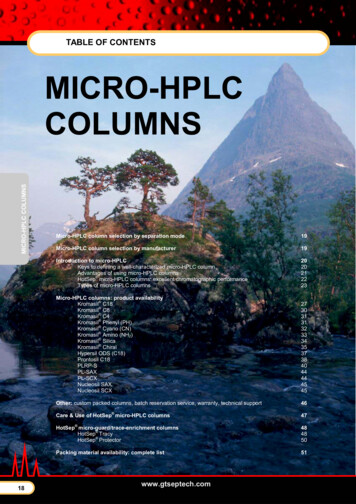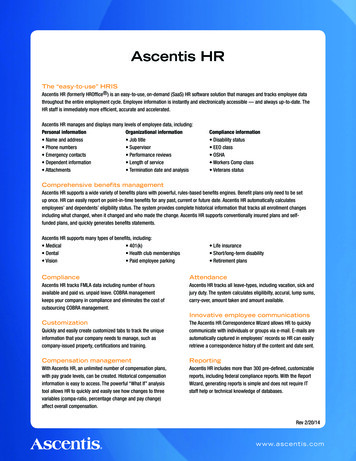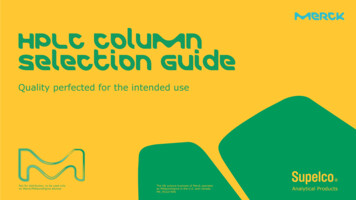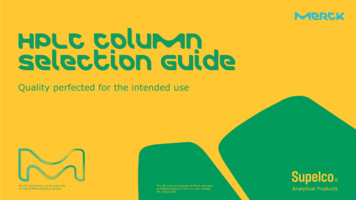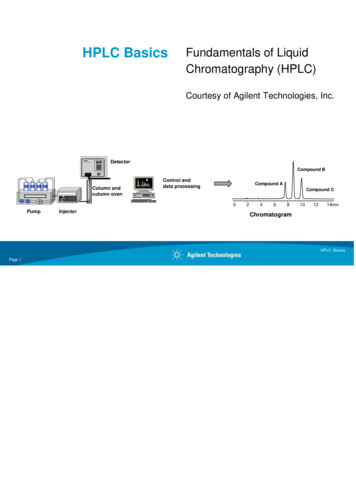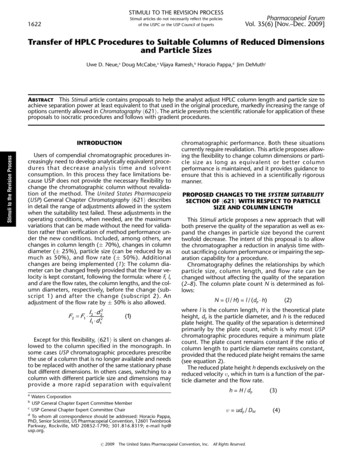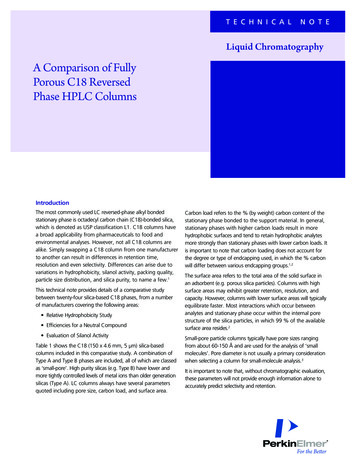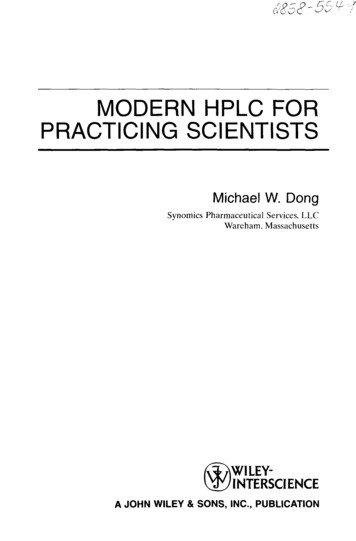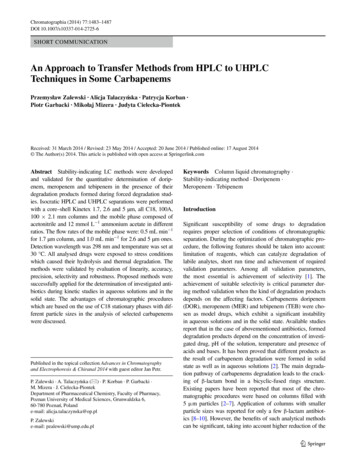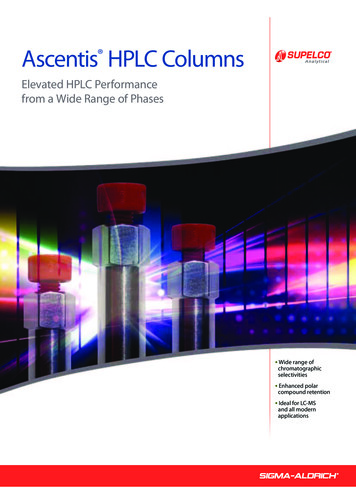
Transcription
Ascentis HPLC ColumnsElevated HPLC Performancefrom a Wide Range of Phasest Wide range ofchromatographicselectivitiest Enhanced polarcompound retentiont Ideal for LC-MSand all modernapplications
Ascentis: Elevated HPLC PerformanceWe have placed heavy emphasis on optimizingAscentis phases with relation to the three terms ofthe resolution equation: efficiency, retention andselectivity. However, our strongest emphasis has been onThe General Features of the Ascentis Family Include:LLthe most powerful term, selectivity. Together, Ascentisbonded phases have a wide range of selectivities.It is likely that one or more Ascentis phase will accomplishany small molecule HPLC separation.LLLPacked in micro- to preparative hardware dimensions,Ascentis products cover all HPLC application areas, includingthe most sensitive trace-level analyses.LLHigh purity, type B silica for inertness, reproducibility and stabilityModern bonding processes that optimize bonded phase coverageand maximize stability, while minimizing bleed and unwantedsecondary interactionsWide selection of bonded phase chemistries and bare silicaPhases with enhanced polar compound retentionCompatible with LC-MS and all of today’s sensitive instrumentsand methodsScalable selectivity from analytical to preparativeHigh surface area silica for high preparative loading capacityAscentis CharacteristicsPhaseUSP CodeKey Competitive FeatureAscentis C18Ascentis RP-AmideL1L60High surface area, inert surfacePhase stability, low bleedAscentis PhenylL11Phase stability, low bleedAscentis ES CyanoL10Phase stabilityAscentis SilicaL3Ascentis C8Discovery HS F5*L7L43High loading capacity, controlled anduniform surface activityHigh surface area, inert surfaceOrthogonal selectivity to C18, ours iswell-characterizedModesPrimary ICReversed-phase,HILIC, 100% AqueousNormal phase(non-aqueous), HILICReversed-phaseReversed-phase,HILIC, ion-exchangeSmall molecules and peptidesExcellent “first choice” alternative to C18 for routineRP method development. Polar molecules, especiallyphenolics and other H-bond donors, acids, bases(uncharged), anilinesRing systems and strong dipoles, P-acids, P-electronacceptors, heteroaromatics, nitroaromaticsPolar compounds, strong dipoles,tricyclic antidepressantsNon-polar compounds (in NP mode), highly-polarcompounds (in HILIC mode), nucleosides, amino acidsSmall molecules and peptidesAll electron and P-electron donors, bases (charged),positional isomersPage9101214161820* We have chosen to include Discovery HS F5 in this brochure because of its complementary selectivity to the Ascentis phases and its benefits for certain analytes.Ascentis HPLC columns represent a continuum of improvement through innovations in HPLC technology.2sigma-aldrich.com/ascentisordering: 800-247-6628 (US only) / 814-359-3441
Developing HPLC Methods on AscentisDiscovery HS F5 – For enhanced retention and performanceSelecting An Ascentis Columnof polar compounds, especially bases (charged) and when theColumn Screening: The Ascentis & Discoverysample contains a mixture of non-polar and polar compoundsMethod Development “Tool Kit”Simply screen these five columns in your desired mobilephase, using your preferred column.We recommend every HPLC method developer have thesefive columns in their arsenal.Choosing an Ascentis or Discovery Phase Based onCompound Class and Separation Challenge or ObjectiveAscentis C18 – Classic C18 selectivity will achievemost reversed-phase separationsTypically, Ascentis C18 is the first choice for starting a newmethod. However, when a C18 doesn’t give the desiredAscentis RP-Amide – For enhanced retention andperformance of polar compounds, especially basesseparation or your sample contains compounds that are(uncharged) and compounds with H-bond potentialknown to be difficult to retain or resolve on a C18, considerAscentis Phenyl – For enhanced retention and performanceof polar compounds, especially ring systems, dipoles, andchanging the stationary phase. The range of selectivitynitroaromaticsThe flow chart below helps guide the selection of AscentisAscentis ES Cyano – Extra stable for low pH mobile phasesor Discovery phase based on the particular compound typedue to sterically protected phase. Useful for polar selectivityin reversed-phase mode. Also useful as an alternative toor separation challenge. For more information about eachsilica in HILIC modededicated pages in this brochure.provided by Ascentis and Discovery phases makes this easy.phase, and the other Ascentis phases, please refer to theirDesire to Improve Retentionor Resolution on C18Non-PolarCompoundsToo MuchRetentionMixture of Polar andNon-Polar CompoundsPolarCompoundsPoor Peak Spacing: Too much retentionof non-polar compounds and/or too littleretention of polar S F5Retention Too Short or Inadequate SeparationH-Bonding,Phenolic,Acidic orHydroxylatedCompoundsP r Peak Shape(Basic Compounds)StrongDipolesVery PolarCompoundsGeometricIsomersNot EnoughRP Retention,LC-MSNot EnoughSeparationP entisSilicaDiscoveryHS henylDiscoveryHS F5AscentisRP-AmideororororAscentis ESCyanoAscentis ESCyanoAscentis ESCyanoAscentis ESCyanoColumn selection guidelines for Ascentis and Discovery phases basedon compound class and separation challenge or objective.TRADEMARKS: ACE - Advanced Chromatography Technologies; Ascentis, Discovery, CHIROBIOTIC, CYCLOBOND, CHIRALDEX, CHROMASOLV - Sigma-Aldrich Biotechnology LP;Fused-Core - Advanced Materials Technology, Inc.; Nucleosil - Machery-Nagel; Prodigy - Luna; Symmetry, XTerra - Waters Corporation; Zorbax - Agilent TechnologiesChromatography Products for Analysis and Purification3
Harnessing the Power ofChromatographic SelectivityChromatographic resolution is a function of columnefficiency (N), retention (k) and selectivity (A). It is usuallyFigure 1. Affect of Selectivity on Improving Resolutionwritten in the form of the resolution equation:When resolution is plotted vs. these three parameters inFigure 1, it becomes apparent that selectivity has thegreatest affect on resolution.The Power to AccomplishDifficult SeparationsOne of the most important reasons why selectivity isleveraged in HPLC is to resolve closely-eluting compounds.A good example of this is the need to quantify a compoundthat elutes in the tail of a more abundant compound,perhaps a low-level impurity in the presence of the parentcompound, like shown in the Figure 2. By altering thestationary phase, in this case going from a C18 to anRP-Amide, the impurity can be eluted before the main peak,thereby allowing more sensitive and reliable quantification.Figure 2. Impurity Eluted on the Downslope of theMain Peak on C18 — Difficult to QuantifyC18IImpurity Eluted Before the Main Peak onAscentis RP-Amide – Better QuantificationAscentisRP-AmideIThe power of chromatographic selectivity is demonstrated in thisexample. The C18 column elutes the impurity in the downslope of themajor peak, limiting the ability to detect and quantify the impurity. Byusing a column with different selectivity, in this case an Ascentis RPAmide, the impurity peak is eluted before the main peak.4sigma-aldrich.com/ascentistechnical service: 800-359-3041 (US and Canada only) / 814-359-3041
Key Ascentis Application AreasPolar Analytes: Enhanced Retention,Selectivity, and Compatibility withHighly-Aqueous Mobile PhasesPolar compounds are difficult to analyze by traditionalreversed-phase because they lack the high proportion ofhydrophobic character necessary for retention. Since mostFigure 4. P-P Interactions (Ascentis Phenyl)column: Ascentis C18, 15 cm x 4.6 mm I.D., 5 µm particles (581324-U)Ascentis Phenyl, 15 cm x 4.6 mm I.D., 5 µm particles (581616-U)mobile phase: 40:60, acetonitrile:waterflow rate: 1.0 mL/min.temp.: 30 Cdet.: UV at 210 nminjection: 5 µLsample: nitrobenzene, m-dinitrobenzene, 1,3,5-trinitrobenzenepharmaceutically- and biologically-active compounds areAscentis Phenylhighly polar, this has presented a continual problem inHPLC. From the beginning of our commitment to HPLCinnovation, we have focused on bonded phase to enhancepolar compound retention.Stationary Phases with Enhanced Polar CompoundG004074Retention Compared to C18Rather than relying solely on dispersive forces to achieveretention, our column portfolio contains bonded phasesAscentis C18that lend additional retentive character toward analyteswith specific polar functional groups.Figure 3. H-bonding (Ascentis RP-Amide)column:mobile phase:flow rate:temp.:det.:injection:Ascentis RP-Amide & C18, 15 cm x 4.6 mm I.D., 5 µm particles70:30, water with 0.1% TFA:acetonitrile1. 4-Hydroxybenzoic Acid1 mL/min2. Acetylsalicylic Acid35 C3. Benzoic AcidUV at 220 nm4. 2-Hydroxybenzoic Acid10 µL5. Ethyl paraben3425Discovery HS F51. Methcathinone2. EphedrineG0040943C18Figure 5. Ion Exchange (Discovery HS F5)column: Discovery HS F5, 15 cm x 4.6 mm I.D., 5 µm particles (567516-U)conventional C18, 15 cm x 4.6 mm I.D., 5 µm particlesmobile phase: 30:70, 10 mM ammonium acetate (pH 6.98): CH3CNflow rate: 2.0 mL/min.temp.: 35 Cdet.: photodiode arrayinjection: 5 µL1Ascentis RP-Amide1G004075Ascentis Phenyl exhibits strong π-π interactions with the π-acidicnitroaromatics. Addition of each nitro group increases 004095Ascentis RP-Amide exhibits strong retention relative to C18 for phenolsand organic acids.012345Min6Discovery HS F5 exhibits enhanced retention from ion exchange interactions with ionized analytes.Chromatography Products for Analysis and Purification5
HILIC Mode: Enhanced Retention and High MS-SuitabilityHighly-polar compounds, like underivatized amino acids,Stability in Highly-Aqueous Mobile PhasesUnless working in HILIC mode, mobile phases for polarnucleosides and nucleotides, are not well-retained byreversed-phase HPLC. However, under HILIC (hydrophiliccompounds are often highly-aqueous, with only smallpercentages of organic modifiers. Under such conditions, C18interaction chromatography) conditions, they can bephases are not wetted, which causes two problems. First, theretained. HILIC is a variation of normal phase HPLC where themobile phase contains high percentages of organic modifier.bonded phase molecules coalesce resulting in phase collapseand subsequent loss of hydrophobic retention. Second,It is also called “aqueous normal phase” or ANP. Under highorganic conditions, polar interactions become prominentanalytes have an unpredictable approach to the silica surface,resulting in irreproducible and unstable retention run-to-runwhich can lead to increased retention. Ascentis Phenyl,and column-to-column. Ascentis Phenyl, Ascentis ES Cyano,Ascentis ES Cyano, Ascentis Silica and Discovery HS F5 exhibitHILIC character under highly-organic mobile phases. AnAscentis RP-Amide, and Discovery HS F5 are completelyaqueous-compatible, and will not undergo phase collapseadded benefit of HILIC mobile phases is the high organiceven in mobile phases that contain 100% water.(often 90%) is amenable to MS detection.Figure 6. Separation of Nucleosides onAscentis Phenylcolumn:mobile phase:flow rate:temp.:det.:injection:123Figure 7. Separation of Organic Acids onAscentis RP-AmideAscentis Phenyl, 15 cm x 2.1 mm I.D., 5 µm particles (581613-U)10 mM ammonium formate (pH 3.0 with formic acid)0.2 mL/min35 CUV at 270 nm1 µL1. Cytidine (0.1 g/L)2. Deoxycytidine (0.1 g/L)3. Uridine (0.1 g/L)4. Guanosine (0.1 g/L)Ascentis Phenyl –5. Adenosine (0.1 g/L)100% Aqueous6. Deoxyguanosine (0.1 g/L)7. Deoxyadenosine (0.1 g/L)Compatible8. Thymidine (0.1 g/L)column: Ascentis RP-Amide, 15 cm x 4.6 mm I.D., 5 µm particles (565324-U)mobile phase: 25 mM monobasic potassium phosphate(pH 3.0 with phosphoric acid)flow rate: 1 mL/min.temp.: 35 Cdet.: UV at 230 nminjection: 10 µL21. Dehydroascorbic acid2. Ascorbic acidAscentis RP-Amide –100% AqueousCompatible546781G004078G002722Selecting the Right BufferA partial list of common buffers and their corresponding useful pH range is supplied. Perhaps the mostcommon buffer in HPLC is the phosphate ion. Although,with the growth of LC-MS, volatile buffers such as TFA,acetate, formate, and ammonia are becoming morefrequently used. Remember, the purpose of a buffer inthe mobile phase is to inhibit a pH change in the mobilephase after the introduction of a sample. Whendeveloping a method, it is important to select a mobilephase with a final pH at least one pH unit away from any6sigma-aldrich.com/ascentisanalytes pK value. As a rule of thumb, one should workwithin a 1 pH unit of the buffer pKa. Typical bufferconcentrations for HPLC tend to be 10-100 millimolar level.BufferTrifluoroacetic acid (TFA)Phosphate 1FormateAcetatePhosphate 2AmmoniaPhosphate 3pKa @ 25 CUseful pH Range0.52.13.84.87.29.212.3 1.51.1 - 3.12.8 - 4.83.8 - 5.86.2 - 8.28.2 - 10.211.3 - 13.3ordering: 800-247-6628 (US only) / 814-359-3441
LC-MS Compatibility Through PhaseStability, Retentivity and InertnessAscentis Provides Scalable Separationsfrom Microbore to PreparativeIn today’s laboratory, HPLC columns and bonded phasesTime and precious samples are wasted during scale-up ifmust be compatible with mass spectrometric detection.Complete MS compatibility is an important design input forthe analytical and preparative columns do not give the sameelution pattern. The high surface area of the underlyingAscentis silica provides high loading capacity to purify largerall Ascentis phases.Negligible Phase BleedLoss of stationary phase can contribute to high background interference in all forms of detection, but it is mostnotable in MS detection where phase bleed can also lead tofouling of the instrument and subsequent downtime forcleaning and repair. Modern bonding procedures and anintelligent selection of the Ascentis phase chemistrycombine to give all Ascentis phases low detectable bleedquantities of material. Additionally, bonded phase and silicachemistry are uniform across 3,5, and 10 µm particle sizes.These features combine to ensure that analytical separationsthat are developed on Ascentis 3 or 5 µm particles arecompletely scalable to preparative separations on Ascentis10 µm particles and larger columns. Additionally, separations developed on 5 or 10 µm particles can be scaled downfor fast analysis on Ascentis 3 µm particles.Lunder MS and sensitive UV detection.Amide Chemistry Avoids the Need for TEAand TFA AdditivesLAscentis 10 µm particles in large column dimensions are ideal forisolating and purifying mg to gram amounts of compounds forfurther characterization.Ascentis 3 µm particles in short columns are ideal for rapid analysisand LC-MS applications.Silanol-suppressing mobile phase additives, like TEA andTFA, are required for good peak shape on traditional HPLCphases. However, because they suppress the MS signal theyshould be avoided. Ascentis RP-Amide, by virture of theembedded amide group, does not require silanol-suppressing additives for good peak shape. Formic acid is a suitableacidic modifier for use with Ascentis RP-Amide columns.Guidelines for PreparingMobile PhasesIt should be understood that slight variations in pH andbuffer concentration could have a dramatic affect on thechromatographic process; consistent and specificAscentis pH Stability: Extending theWorking pH Rangetechniques should be a regular practice in the prepara-Occasionally, HPLC mobile phases outside the normal pH2-7 range are desired to control sample stability, solubility orand add an accurate amount of buffer. The pH of the solu-ionization state, or for compatibility with detection methods.final volume of water prior to adding or blending ofA limitation of most silica-based HPLC phases is theirinstability outside this range where hydrolysis of the bondedorganic solvents. Then, add a volumetrically measuredphase and dissolution of the underlying silica can occur.Ascentis columns have excellent stability compared tophase. Thorough blending, degassing, and filtering priorcompetitive silica-based columns. The high bonded phasecoverage and proprietary endcapping combine to increaseresistance to hydrolysis and dissolution. As a result, Ascentistion of mobile phases. A common practice is to place asufficient amount of pure water into a volumetric flasktion should be adjusted, if necessary, and then dilute toamount of organic solvent to obtain the final mobileto use is also recommended.To view a listing of suitable HPLC and LC-MS additivesand solvents, visit sigma-aldrich.com/lc-ms-solventscolumns can be used successfully between pH 1.5-10 undercertain conditions. Note, however, that it is important to avoidstoring Ascentis columns, and any silica-based column, inharsh mobile phases.Chromatography Products for Analysis and Purification7
Ascentis C18The First Choice for Classic C18 Retention and SelectivityOptimization of silica and bonded phases make Ascentis C18 a true workhorse for the vast majority of HPLC separations. Highsurface area and phase stability give it perfect character for demanding LC-MS and preparative separations.Features:LLLLLKey Applications:Classic C18 selectivityHigh non-polar retentivitySymmetric peak shapeHighly reproducible and stableIdeal for LC-MSGeneral reversed phase, hydrophobic and polar compoundsProperties:USP code:Bonded phase description:Endcapped:Particle composition:Particle purity:Particle shape:Particle size:Pore size:Surface area:Carbon load:pH range (recommended):Extended pH range*:L1OctadecylYesType B silica gel 5 ppm metalsSpherical3, 5 and 10 µm100 Å450 m2/g25%2-81.5-10Characterization of Chromatographic Performance on Ascentis C18Acidic Ion Exchange Capacity at pH 2.7Ion Exchange Capacity at pH 7.6Hydrogen Bonding CapacityShape SelectivityHydrophobic SelectivityHydrophobic RetentionAll competitive data obtained from M. R. Euerby, P. Perterson, J. Chromatogr. A, 994 (2003) 13-36; or M. R. Euerby, P. Perterson, W. Campbell, W. Roe, J. Chromatogr. A, 1154 (2007)138-151. Ascentis data developed by Supelco/Sigma-Aldrich scientists using the Euerby methodology or obtained directly from cited references. Data for Aromatic selectivity is calculatedas aTNB/NB/aTNB/DNT.UseNotesThe classic reversed-phase column, Ascentis C18 is suitablefor any method that specifies a C18-type column. Its highModern C18 columns have very similar selectivity, even forbasic compounds, because silica quality and bondingsurface area gives Ascentis C18 strong hydrophobic retentionand high loading capacity for preparative applications.techniques have improved to the point that silanol effectsissue, the main reasons for evaluating different brands ofLC-MS ImplicationsC18 columns are for improved peak shape and for slightAscentis C18 is low-bleed for clean ESI and APCI traces.The high retentivity means that the mobile phase cancontain high levels of organic modifier that are morereadily desolvated.8sigma-aldrich.com/ascentisare minimal. Unless quality with your current column is thechanges in selectivity.* Under certain conditions, the Ascentis family can be operated in the extended pH range. Formore information, request an electronic file of “Acid/Base Stability of Silica Based on C8, C18,and Amide HPLC Columns” (T406018)technical service: 800-359-3041 (US and Canada only) / 814-359-3041
Ascentis C18 is one of the mostretentive reversed-phase columnsavailable. High retentivity extendsthe linear range of loading capacity,making Ascentis C18 ideal forseparations that are or might beused for preparative applications.High retentivity also meansAscentis C18 can accommodate thehighly-organic mobile phasesencountered in LC-MS.Ascentis C18: Top of Its Class in Hydrophobic RetentivityAscentis C18Prodigy ODS-3Zorbax Extend-C18Symmetry C18Luna C18 (2)Nucleosil C18ACE C18XTerra MS C18Discovery C18012345k Pentylbenzene6789All competitive data obtained from M. R. Euerby, P. Perterson, J. Chromatogr. A, 994 (2003) 13-36; or M. R. Euerby, P. Perterson, W. Campbell,W. Roe, J. Chromatogr. A, 1154 (2007) 138-151. Ascentis data developed by Supelco/Sigma-Aldrich scientists using the Euerby methodology orobtained directly from cited references. Data for Aromatic selectivity is calculatedas aTNB/NB/aTNB/DNT.Analysis of basic compounds atneutral pH often gives longerretention compared to acidicmobile phases, but sometimescauses poor peak shape due tosilanol interactions. The highly-inertsurface of Ascentis C18, as with allAscentis phases, permits analysis inneutral pH mobile phases. In thisexample, a mix of tricyclic antidepressants at pH 7 shows excellentpeak shape on Ascentis C18.Figure 8. Symmetrical Peaks for Basic Compounds Indicative ofHigh Surface Deactivation of Ascentis Phasescolumn: Ascentis C18, 15 cm x 4.6 mm I.D., 5 µm particles (565324-U)mobile phase: 30:70; 25 mM ammonium phosphate,1pH 7.0: methanolflow rate: 1.5 mL/min.3temp.: 35 Cdet.: UV at 254 nminj.: 20 µL41.2.3.4.5.6.7.8.Desmethyl entis C18 provides theselectivity and retention for a rangeof compounds including steroids.Ascentis C18 is a reliable first choiceHPLC column that gives symmetricpeak shape and excellent retentionfor even difficult compounds.Figure 9. Estrogenic Steroids on Ascentis C18column:mobile phase:flow rate:temp.:det.:inj.:1.2.3.4.Ascentis C18, 15 cm x 4.6 mm I.D., 5 µm particles (581324-U)55:45, water:acetonitrile1 mL/min.35 CUV at 220 nm10 µLEstriolA-EstriolB-EstriolEstroneChromatography Products for Analysis and Purification9
Ascentis RP-AmideUltra-Low Bleed Alkyl Amide Phase that Rivals C18 as a Generic Scouting Column.Excellent Peak Shape and Resolution, Especially for Polar Compounds or Mixturesof Compound PolarityAs pioneers in embedded polar group (EPG) phases for HPLC, Supelco is pleased to offer Ascentis RP-Amide, which has all thebenefits of enhanced polar compound retention and selectivity, without any of the disadvantages of competitive EPG phases.FeaturesLLLLKey ApplicationsImproved peak shape for bases compared to C18Different selectivity than C18 or C8 for wide rangeof polar compounds (especially acids)Lower bleed than competitive EPG phases100% aqueous compatibleSmall, water soluble molecules and peptides, H-bond donors,acids, phenols, basic compounds, polar compoundsPropertiesUSP code: L60Bonded phase description: Stable amide group embedded in an18-carbon chainEndcapped: YesParticle composition: Type B silica gelParticle purity: 5 ppm metalsParticle shape: SphericalParticle size: 3, 5 and 10 µmPore size: 100 ÅSurface area: 450 m2/gCarbon load: 19.5%pH range (recommended): 2-8Extended pH range*: 1.5-10Characterization of Chromatographic Performance on Ascentis RP-AmideAcidic Ion Exchange Capacity at pH 2.7Ion Exchange Capacity at pH 7.6Hydrogen Bonding CapacityShape SelectivityHydrophobic SelectivityHydrophobic RetentionAll competitive data obtained from M. R. Euerby, P. Perterson, J. Chromatogr. A, 994 (2003) 13-36; or M. R. Euerby, P. Perterson, W. Campbell, W. Roe, J. Chromatogr. A, 1154 (2007) 138-151. Ascentis data developedby Supelco/Sigma-Aldrich scientists using the Euerby methodology or obtained directly from cited references. Data for Aromatic selectivity is calculated as aTNB/NB/aTNB/DNT.UseAscentis RP-Amide can be used for many of the sameUnlike other amide-based phases, Ascentis RP-Amide usesseparations as a C18 while avoiding some of the disadvan-an amidosilane reagent and a one-step bonding methodtages of C18 such as poor wettability in high aqueous mobilephases. In addition, it is much more retentive for thosesimilar to C18. Polymeric reagents are also employed tomolecules that can interact by hydrophobic interactions andHPLC detectors.also by H-bonding with the amide group. Compared toalkyl-only phases, Ascentis RP-Amide has enhanced retentionNotesand selectivity for phenols, organic acids and other polarsolutes due to strong H-bonding between the amide carbonyl(H-bond acceptor) and H-bond donors, like phenols and acids.Compared to other EPG phases, like carbamates, ureas,sulfonamides and ethers, Ascentis RP-Amide gives retentioncomparable to C18 and C8 for easy column comparisonwithout the need to change mobile phase conditions.10LC-MS Considerationssigma-aldrich.com/ascentisachieve maximum stability and low bleed with all modernLLGenerally, acids are retained more and bases retained less onRP-Amide compared to C18 and C8 columns.Methanol can be comparable in elution strength to acetonitrilewhen compounds are retained by H-bonding mechanism on theRP-Amide phase.* Under certain conditions, the Ascentis family can be operated in the extended pH range. Formore information, request an electronic file of “Acid/Base Stability of Silica Based on C8, C18,and Amide HPLC Columns” (T406018)ordering: 800-247-6628 (US only) / 814-359-3441
Figure 10. Structure of Ascentis RP-AmideFigure 12. Enhanced Phenolic Compound Retention via H-bonding on Ascentis RP-Amidecolumn:mobile phase:flow rate:temp.:det.:injection:G003757Ascentis RP-Amide, 15 cm x 4.6 mm I.D., 5 µm particles (565324-U)75:25, 20 mM phosphoric acid:acetonitrile1.5 mL/min30 COHUV at 270 nmResorcinol1 µL1.2.3.4.5.6.7.Because the amide group lies near the silica surface, it isbelieved to suppress tailing of basic solutes by electrostaticshielding (repulsion) or by interacting preferentially with thesilanols (H-bonding between the phase and the substrate).The absence of unwanted silanol and other secondaryinteractions gives the Ascentis RP-Amide excellent peakshape for both acids and bases. This example of internaldeactivation with acetaminophen and pseudoephedrine(Figure 11) shows the dramatic effect of changing stationaryResorcinolCatechol2-Methyl resorcinol4-Methyl catechol2,5-Dimethyl resorcinol3-Methyl catechol4-Nitro catecholOHCatechol2OHG0025901Ascentis RP-Amidephase: not only are the peaks more symmetrical, but elutionorder is reversed.4635Figure 11. Improved Efficiency, Selectivity andResolution of Ascentis RP-Amide vs. C18column: Ascentis RP-Amide, 15 cm x 4.6 mm I.D., 5 µm particles (565324-U)Ascentis C18, 15 cm x 4.6 mm I.D., 5 µm particles (581324-U)mobile phase: 15:85, acetonitrile: 25 mM potassium phosphateflow rate: 1 mL/min.1temp.: 35 Cdet.: UV at 214 nminj.: 10 µL1. Acetaminophen2. PseudoephedrineOHG0025947G003592212C18Ascentis C1841.02.03.04.0Min35.07G0037882651Ascentis or EPGAn Ascentis RP-Amide column is more retentive andselective for phenolic compounds, like catechols andresorcinols, compared to a C18 and an ether-type polar43embedded phase (Figure 12). The ether phase does nothave the ability to H-bond with phenolic groups like theamide group does. Although comparing an ether phase to5a C18 phase may be useful if only slightly different selectivity is needed, the most dramatic results for acids such asphenols and carboxylic acids will be obtained with024MinG003790amide-based phases, like Ascentis RP-Amide.Chromatography Products for Analysis and Purification11
Ascentis PhenylUltra-low Bleed Phenyl Phase with Enhanced Phenyl SelectivityPhenyl-based reversed-phases were one of the first alternatives to C18 selectivity. Our Ascentis Phenyl has been improved to offerexceptional phase stability and enhanced phenyl retention. Ascentis Phenyl offers versatility by also operating in the HILIC mode.FeaturesLLLKey ApplicationsLow-bleed for MS or UV gradient applicationsdue to the use of trifunctional bonding reagentOutstanding phenyl selectivity due to highphase loading and short butyl spacer100% aqueous-compatible for highly-polarcompoundsSmall, water soluble molecules and peptides, π-acceptors, nitroaromatics,polar compounds, dipoles, heterocyclics, HILIC modePropertiesUSP code:Bonded phase description:Endcapped:Particle composition:Particle purity:Particle shape:Particle size:Pore size:Surface area:Carbon load:pH range (recommended):Extended pH range*:L11Phenyl ring with short butyl spacerYesType B silica gel 5 ppm metalsSpherical3, 5 and 10 µm100 Å450 m2/g19.5%2-81.5-10Characterization of Chromatographic Performance on Ascentis PhenylAcidic Ion Exchange Capacity at pH 2.7Ion Exchange Capacity at pH 7.6Hydrogen Bonding CapacityShape SelectivityHydrophobic SelectivityHydrophobic RetentionAll competitive data obtained from M. R. Euerby, P. Perterson, J. Chromatogr. A, 994 (2003) 13-36; or M. R. Euerby, P. Perterson, W. Campbell, W. Roe, J. Chromatogr. A, 1154 (2007) 138-151. Ascentis data developedby Supelco/Sigma-Aldrich scientists using the Euerby methodology or obtained directly from cited references. Data for Aromatic selectivity is calculated as aTNB/NB/aTNB/DNT.UseNotesPhenyl phases are P-basic (electron donating) and aresimilar in overall retention to alkyl and EPG phases for easyLcolumn screening. The alternate selectivity of phenyl phasesLis often explained by the P-P interactions available throughthe phenyl ring. Compounds that appear to exhibit differential selectivity on the phenyl phase include:LLLLLL12Methanol can be a more selective mobile phasecomponent than acetonitrile.Activate HILIC mode by using highly-aqueous( 90%) mobile phases.* Under certain conditions, the Ascentis family can be operated in the extended pH range. Formore information, request an electronic file of “Acid/Base Stability of Silica Based on C8, C18,and Amide HPLC Columns” (T406018)hydrophobic bases (TCAs, tetracyclines)moderate bases (anesthetics and narcotic analgesics)benzodiazepinessome acidic compounds such as ACE inhibitors andquinoline antibioticsnucleosides (e.g. cytidine)nitro, azide and sulfonyl compoundssigma-aldrich.com/ascentistechnical service: 800-359-3041 (US and Canada only) / 814-359-3041
Aromatic Selectivity - PhenylFigure 13. Structure ofAscentis PhenylAscentis PhenylLuna Phenyl HexylXBri
Ascentis ES Cyano, Ascentis Silica and Discovery HS F5 exhibit HILIC character under highly-organic mobile phases. An added beneFt of HILIC mobile phases is the high organic (often 90%) is amenable to MS detection. Figure 7. Separation of Organic Acids on Ascentis RP-Amide column: Ascentis RP-Amide, 15 cm x 4.6 mm I.D., 5 µm particles (565324-U)
